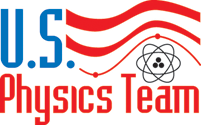United States National Physics Olympiad
From Wikipedia, the free encyclopedia
The United States National Physics Olympiad (USAPhO) is a high school physics competition run by the American Association of Physics Teachers and American Institute of Physics to select the team to represent USA at the International Physics Olympiad (IPhO). The team is selected through a series of exams testing their problem solving abilities. The top 20 finalists are invited to a rigorous study camp at University of Maryland to prepare for the IPhO.
The 1986 team was made up of 20 talented high school physics students who had been nominated by their teachers. Five students were selected for the International Physics Olympiad after a rigorous preparation by University of Maryland. At the 1986 London IPhO, the team brought home three bronze medals.
Since then, the US Physics Team has been very successful at the International competition, usually placing in the top ten nations. It has accumulated 46 Gold Medals, 33 Silver Medals, 29 Bronze Medals, and 11 Honorable Mentions at IPhO as of 2012.[1]
Contents
History
The International Physics Olympiad began in 1967 among Eastern European countries and many western countries soon joined in the 1970s. In 1986, Jack Wilson, AAPT Executive Officer, the American Association of Physics Teachers organized the United States Physics Team for the first time.The 1986 team was made up of 20 talented high school physics students who had been nominated by their teachers. Five students were selected for the International Physics Olympiad after a rigorous preparation by University of Maryland. At the 1986 London IPhO, the team brought home three bronze medals.
Since then, the US Physics Team has been very successful at the International competition, usually placing in the top ten nations. It has accumulated 46 Gold Medals, 33 Silver Medals, 29 Bronze Medals, and 11 Honorable Mentions at IPhO as of 2012.[1]
Physics Team Selection
The current procedure to select the U.S. Physics Team consists of two exams and then a study camp, the preliminary "F=ma" Exam and the Semifinals. In previous years, there have been free response questions on the preliminary round as well as a quarterfinal round in between the preliminary and semifinal. As of 2013, there are only two rounds of testing. [2]Preliminary Exam
This exam is known as the F = ma contest. There are 25 multiple choice questions in 75 minutes focusing only on noncalculus mechanics. One point is awarded for each correct answer and a quarter point penalty deducted for each incorrect answer. The cut-off was 15.5 in 2012 and 12.25 in 2013.[3] [4]Semifinal Exam
The top 300-400 students from the preliminary exam will be invited to take this free response exam covering all topics in introductory physics: Mechanics, Electiricy and Magnetism, Thermodynamics, Fluids, Relativity, Nuclear and Atomic Physics, and Waves and Optics. Some simple calculus may be needed on some of the questions. There are two parts in the exam. Part A has 4 problems to do in 90 minutes. Part B has 2 problems to do in 90 minutes.Training Camp
The top 20 finalists in the nation based off the scores of the above exams are invited to a rigorous training camp at the University of Maryland. There students receive heavy theoretical and experimental training and take a barrage of tests. Finally, the top five students are selected to participate in the International Physics Olympiad.Recognition
All semifinalists receive certificates as a reward for their physics skill. Starting in 2013, medal rankings are also awarded to the top scores on the Semifinal exam. Gold is about top 10%, Silver is about top 20%, Bronze is about top 40% and Honorable Mention is about top 66%.Reception
The Physics Olympiad has been well received by many teachers and students who are attempting to promote and nurture interests in the increasingly demanding field of physics.External links
References
- Jump up ^ "Program and History". Retrieved 11 May 2013.
- Jump up ^ "2013 Registration". Bottom of the Page. Retrieved 9 May 2013.
- Jump up ^ "2012 US Physics Team Page". Bottom of Page. Retrieved 9 May 2013.
- Jump up ^ "2013 US Physics Team Page". Retrieved 9 May 2013.

No comments:
Post a Comment